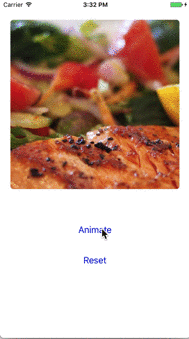トリックは、イメージモードのフレームを混乱させて、コンテンツモードが変化しているように再描画して見えるようにすることです。これを行うことで、フレームや制約を操作し、別のビュー内でマスクすることができます。例を実行し、私に教えてください。
import UIKit
class ViewController: UIViewController {
var imageView = UIImageView()
var maskView = UIView()
var frame : CGRect = .zero
override func viewDidLoad() {
super.viewDidLoad()
// Do any additional setup after loading the view, typically from a nib.
view.layoutIfNeeded()
imageView = UIImageView(frame: CGRect(x: 20, y: 40, width: view.bounds.width-40, height: view.bounds.height/2))
imageView.image = UIImage(named: "img")
imageView.contentMode = .scaleAspectFill
maskView = UIView(frame: CGRect(x: 20, y: 40, width: view.bounds.width-40, height: view.bounds.height/2))
maskView.addSubview(imageView)
maskView.layer.masksToBounds = true
maskView.layer.cornerRadius = 6
self.view.addSubview(maskView)
//manipulate the imageView to make the content mode seem to change
// and have it redraw itself
frame = imageView.frame
var newFrame = frame
newFrame.size.height += newFrame.height
imageView.frame = newFrame
imageView.center = maskView.center
let button = UIButton(frame: CGRect(x: 20, y: maskView.frame.maxY + 60, width: view.bounds.width - 40, height: 40))
button.setTitle("Animate", for: .normal)
button.setTitleColor(.blue, for: .normal)
button.addTarget(self, action: #selector(ViewController.pressed), for: .touchUpInside)
self.view.addSubview(button)
let AnotherButton = UIButton(frame: CGRect(x: 20, y: button.frame.maxY + 20, width: view.bounds.width - 40, height: 40))
AnotherButton.setTitle("Reset", for: .normal)
AnotherButton.setTitleColor(.blue, for: .normal)
AnotherButton.addTarget(self, action: #selector(ViewController.reset), for: .touchUpInside)
self.view.addSubview(AnotherButton)
}
func pressed() {
//animate
// screw around with the imageView back to the original frame
// you could also do this with the height constraints if it was constraint based
UIView.animate(withDuration: 1.0, delay: 0, usingSpringWithDamping: 1, initialSpringVelocity: 1.0, options: .curveEaseOut, animations: {
self.imageView.frame = self.maskView.bounds
}, completion: nil)
}
func reset() {
//reset big frame
var newFrame = frame
newFrame.size.height += newFrame.height
UIView.animate(withDuration: 1.0, delay: 0, usingSpringWithDamping: 1.0, initialSpringVelocity: 1.0, options: .curveEaseOut, animations: {
self.imageView.frame = newFrame
self.imageView.center = self.maskView.center
}, completion: nil)
}
}
結果: 

あなたはそれが/クリップImageViewのをマスクするために保持するビューを必要としています。そして、変換をcell.coverImageView.transform = CGAffineTransform(scaleX:1.5、y:1.5)のように設定し、アニメーションでcell.coverImageView.transform = .identity – agibson007
を実行します。これはwillDisplayCellで拡大しますが、アニメーションを呼び出すためにscrollviewDidScrolllの画面上にあることを確認する – agibson007
@ agibson007ありがとう!しかし、どうすれば 'let cell = tableView.dequeueReusableCell(withIdentifier:" CardCell "、for:indexPath)を! CardSchedule'部分に 'didScroll'部分がありますか?ズームインするにはどうすればよいでしょうか?indexPath.row? –